| Title | Pages |
|---|---|
| Investigation of Antimicrobial Activity of Pyocyanin Produced by Pseudomonas aeruginosa Strains Isolated from Different Clinical Specimens Pyocyanin is the characteristic blue-green phenazine pigment produced by Pseudomonas aeruginosa stra- ins. The aim of our study is to determine the highest amount of pyocyanin production in P. aeruginosa strains and to investigate the antimicrobial effect of pyocyanin pigment on Escherichia coli, Bacillus sp., Pseu- domonas aeruginosa, Candida sp. and Aspergillus niger. For this purpose, pyocyanin was extracted from P. ae- ruginosa culture supernatants and purified, and then it was measured by spectrophotometrically. P. aerugino- sa A10 strain isolated from urine specimen was determined as the highest amount of pyocyanin producer and P. aeruginosa A1 strain isolated from abdomen was the lowest. The ‘Agar Well Diffusion’ method was carried out to determine the antimicrobial effect of pyocyanin. Accordingly, pyocyanin was effective as an antimicrobial agent on Bacillus sp., Escherichia coli and Candida sp., but there was no antimicrobial effect on P. aeruginosa and A. niger. After that ‘Tube Dilution Method’ was used on strains, which were determined as sensitive to pyocyanin with agar well diffusion method. An increase in the intensity of Bacillus sp. and Candida sp. strains’ growth with decreasing the concentration of pyocyanin was observed. 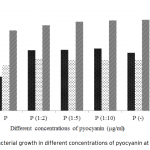
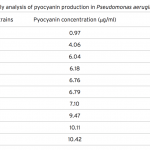

|
1 - 6 |
| Castanea sativa; A Source of Turkish Propolis: Plant Anatomy, Palynology and Chemistry In this study, we aimed to search the anatomical and palynological characteristics of Castanea sativa which is a botanical source for Turkish propolis. Within this context, we investigated the transverse section of leaf and stem of Castanea sativa. We observed palisade and spongy parenchyma, upper and lower epidermis, schle- renchyma and vascular bundles in the transverse section of the leaf by microscopic examination. We observed periderm, schlerencymatic tissue, secondary xylem, secondary phloem, vascular cambium and a parenchyma- tic pith in the tranverse section of the stem. By palynological analysis pollen grains are found radially symmet- ric, isopolar and tricolporate. Besides the microscopic analysis, the chemical content of Castanea sativa propo- lis was analysed by Gas Chromatography and Mass Spectrometry (GC-MS). Alcohols, aldehydes, aliphatic acids and their esters, carboxylic acids and their esters, cinnamic acids and their esters, flavonoids, hydrocarbons, and ketones were determined by chemical analysis of propolis ethanol extract. “Benzoic acid“was found in hig- hest ratio 7.88% in the extract. The anatomical, palynological and chemical results of this study will be guide for further researchs about beekeeping and bee products in Turkey. 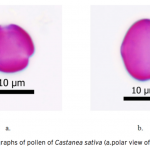
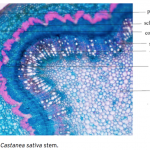
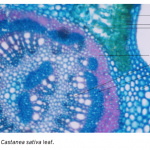
|
7 - 14 |
| Encountered Pollen in Nests Two Osmia Species (Hym.:Megachilidae) from Sweet Cherry Orchards in Sultandağı Town (Afyonkarahisar, Turkey) Osmia species (Hym.: Megachilidae) are important because they can continue even their pollinator activity in orchards in the unfavourable weather conditions for honey bees. In the study, the pollen encountered in the artificial nests of Osmia bicornis (L.) and O. caerulescens (L.) used for supporting their populations in the sweet cherry orchards were analysed. The nests were established in two cherry orchards of Sultandağı town (Afyonkarahisar, Turkey) in April of 2009 and 2010 and removed in September of the same years. Pollen samples were obtained from total 11 nests of O. bicornis and 6 nests of O. caerulescens. Total 4800 pollen grains were examined. As a result of the diagnosis studies of pollen grains, it determined that two species collected the pollens of 6 families and that the dominant pollen group belonged to the Brassicaceae (60.1%) for O. bicornis while Fabaceae (48.2%) for O. caerulescens. The second pollen group were Rosaceae (20.7%) for O. bicornis while Asteraceae (11.8%) for O. caerulescens. In the nests of O. caerulescens, 2.8% Rosaceae pollen were encountered. According to these results, the effect of O. bicornis is higher than O. caerulescens’s on sweet cherry pollination. 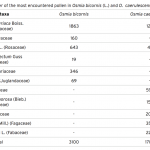
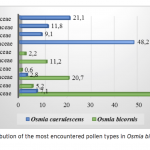
|
15 - 19 |
| A New Anthracocystis (Ustilaginales) Record for Turkey Asmut species, Anthracocystis penniseti (Rabenh.) McTaggart & R.G. Shivas (Ustilaginaceae) on Pennisetum orientale Rich. (Poaceae) is reported for the first time from Turkey. The morphological and microscopical features of this fungi are described with figures. 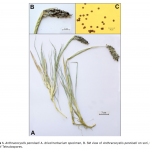
|
21 - 24 |
| Chemical Composition of the Essential Oil of Scutellaria orientalis L. subsp. virens (Boiss. & Kotschy) J. R. Edm. from Turkey In this study, chemical composition of the essential oil of Scutellaria orientalis L. subsp. virens (Boiss. & Kotschy) J. R. Edm (Lamiaceae), collected from Malatya, Turkey, was determined. The essential oil was obta- ined by hydrodistillation from the aerial parts and analyzed by gas chromatography- mass spectometry. Thirty three constituents were identified from the essential oil of Scutellaria orientalis subsp. virens representing 89.29% of total. β-Caryophyllene (22.08%), γ-Cadinene (19.92%), Camphene (6.00%) and Calarene (5.94%) are established as the major components of the essential oil. The results of the analyzed taxa are compared with the previous studies. 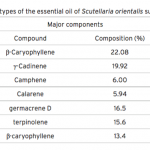
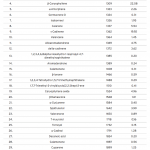
|
25 - 28 |
| Analysis of the Essential Oils of two Hypericum species (H. Lanuginosum var. lanuginosum Lam. and H. perforatum L.) from Turkey The chemical composition of the essential oils of aerial parts of Hypericum lanuginosum var. lanuginosum Lam. and Hypericum perforatum L. were analyzed by GC and GC-MS. Forty one compounds were identified in the essential oils of H. lanuginosum with spathulenol (17.3%), caryophyllene oxide (13.1%), α-pinene (11.7%) and undecane (6.2%) as main constituents. Forty components were identified in the oil of H. perforatum with β-selinene (19.4%), bicyclogermacrene (15.3%), 2 tetradecene (8.2%) and α-amorphene (8.1%) as the most abundant components. 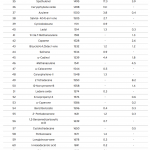
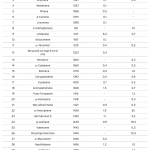
|
29 - 34 |
| Effectiveness of Organic Acid Treatments for Inhibition and Removal of E. coli Biofilms This study was carried out to evaluate the efficacies of organic acid (citric, malic and gallic acids) treatments at 1% and 2% concentrations for prevention and removal of E. coli biofilms. Antibiofilm effects of organic acids were compared with chlorine (100 ppm and 200 ppm) on both microtitration plate and stainless steel coupons for 5, 10 and 20 min. Results indicated that citric acid treatments when compared to the chlorine tre- atments were effective for inhibition and removal of E. coli biofilms. On the other hand, gallic acid treatments were found to be more effective than malic acid treatments. On stainless steel surfaces, the inhibition and re- moval of biofilms were observed to be higher than those found on microtitration plates. Moreover, the inhibiti- on and removal ratios were calculated to be higher with increasing concentrations of sanitizers, on 24-h biofilm, on stainless steel coupons and with 20 min treatments. The results of this study indicates chlorine treatments could be replaced by organic acid treatments for inhibition and removal of biofilm formations of E. coli strains on different food contact surfaces. In addition, organic acid treatments are safe-to-use potential alternatives in industrial applications to chlorine treatments which is toxic to health and environment. 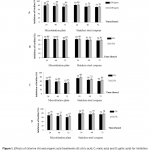
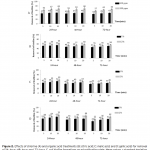
|
35 - 45 |
| Biodiversity in Urban environments of Ordu City and Nearby Areas: Mammals, Birds, Reptiles and Amphibians The present paper provides the first species list of the fauna of terrestrial vertebrates of Ordu, Turkey. A survey for determination of the fauna was conducted between 2011 and 2015 in Ordu and the immediate vici- nity. The field studies were made using several different techniques including; visual, wildlife photography and passive infrared camera traps. Previous records and wildlife observations around Ordu city published by pro- fessional wildlife photographers were also included. Overall, we determined 219 terrestrial vertebrate species (168 birds, 40 mammals, 7 reptiles, and 4 amphibians), some of them being low conservation concern. Among the most remarkable species from the conservation point of view, Emys orbicularis (Reptilia), Aythya nyroca, Puffinus yelkouan, Pelecanus crispus, Saxicola maurus, Tetrax tetrax (Aves), Rhinolophus euryale, Miniopterus schreibersii, Lutra lutra (Mammalia) come into prominence. The third record of the Rustic Bunting (Emberiza rustica) for Turkey is made in this study. In the Blacksea region of Turkey, although the most records of Roe Deer (Capreolus capreolus) is largely confined to mountainous regions, it was captured by the photo-traps in the urban areas. Our results suggest that biodiversity of terrestrial vertebrates in Ordu and immediate vicinity is still rich, and adjacent environments between urban and wild habitats are important in terms of conservation of the urban biodiversity. 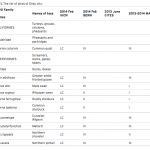
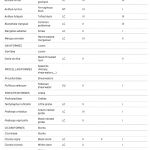
|
47 - 53 |
| Pectinase Production with Waste Materials by Local Water Isolate of Aspergillus fumigatus Strain 2101 and Purification and Characterization of the Enzyme In this study, pectin lyase (PL) was obtained from Aspergillus fumigatus strain 2101 which was isolated from local water sources. PL was purified using ammonium sulphate precipitation, gel filtration and ion-exchange chromatography. After these purification steps, 12.4 purification fold was obtained. The optimum pH and tem- perature of PL were 8.0 and 40 ̊C at 70 min, respectively. The molecular weight of PL was 11.5 kDa. Maximum PL activity was obtained with fruit pulps in submerged culture medium. Stability assays showed that the PL was stable till 20 months at 4 ̊C. The highest PL activity was obtained using citrus pectin as carbon source. PL was strongly activated by FeSO4, FeCl3 and ascorbic acid. 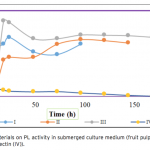
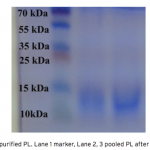
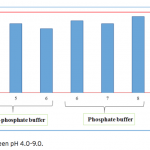
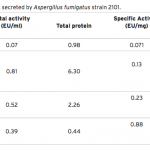
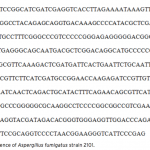
|
65 - 75 |
| Phanerochaete Chrysosporium Loaded Cryogel Column for Biosorption of Mercury (II) Ions from Aqueous Solutions The focus of present study was to evaluate the potential of Phanerochaete chrysosporium loaded monolithic composite cryogel columns for the removal of Hg2+ ions from aqueous environments. The swelling degree of the composite column was 6.68 g H2O/g whereas the plain cryogel column was observed as 7.12 g H2O/g. Optimum working conditions for the column were determined. The reuse of the column was investigated and the results showed that this specific column can be used heaps of times with observing no decrement the Hg2+ biosorption capacity significantly. Synthetic wastewater studies were also applied and the biosorption capacity for Hg2+ was 75.22 mg/g. 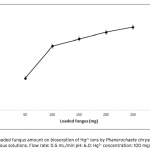
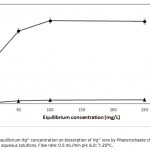
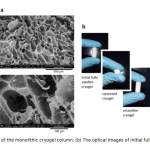
|
77 - 86 |
| Process Optimization for Endoglucanase Production by in Submerged Fermentation In this study, endoglucanase was produced from Trichoderma harzianum in submerged fermentation using sugarcane as a substrate. For enhanced enzyme production, various parameters were optimized by one factor at a time approach. Maximum enzyme yield was obtained with initial medium pH of 4.0, inoculum size of 2%, sugarcane bagasse concentration of 2% and incubation temperature of 30ºC for 72 h of fermentation period. Addition of tween-80 (0.2%) to the fermentation medium had significant impact on endoglucanase production. Further supplementation of glucose and NaNO3 as synthetic carbon and nitrogen source favoured enzyme pro- duction respectively. Results of this study are very helpful in large scale enzyme production. 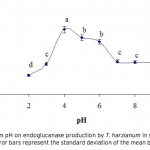
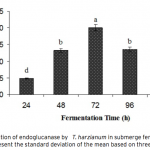
|
87 - 93 |
| Crystal Structure, Thermal Analysis, Spectroscopic Studies and DFT Calculations on Hexaaquamagnesium(II) Acesulfamate The crystal structure of the complex, [Mg(H2O)6](C4H4NO4S)2, was determined at 296 K. The unit cell parame- ters of the crystal structure are a=6.9404 Å, b=8.5775 Å, c=8.7200 Å, α=68.564°, β=78.640°, γ=81.260° and Z=1. The complex crystallizes in the centrosymmetric triclinic space group P-1. The Mg(II) ion is coordinated by six O atoms from six aqua ligands and in the crystal structure, the anions and cations are linked with three dimensions via O—H···O and O—H···N interactions. In addition to the structure which was obtained by X-ray diffraction technique, the theoretical structure was calculated by using density functional theory (B3LYP) with the 6-31G basis sets. The molecular electrostatic potential, frontier molecular orbitals and theoretical IR studies were calculated by using DFT method. Besides, the experimental IR spectrum and thermal analysis were investigated for the complex. 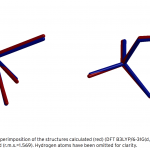
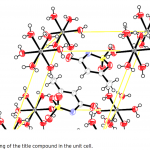
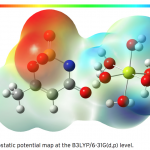
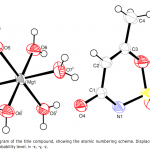
|
95 - 106 |
| Genetic Variation and Microevolution at Allozyme Loci in Eastern Mediterranean Populations of the Geometrid Moth Cyclophora Puppillaria (Lepidoptera) Genetic variation at 7 allozyme loci were determined in 4 Meditarranean populations of the moth Cyclophora puppillaria. Polymorphism levels, and gene diversities as Hardy-Weinberg heterozygosities are mostly substantial for the loci except for those in one of the samples. Pairwise genetic distances between the samples are expressed as FST values, and a high degree of differentiation exists for almost all of the pairwise comparisons. A test of natural selection, Ewens-Watterson test of neutrality, shows no sign of selective difference among electrophoretic allelic states over loci in all samples. Our results presents the the first picture of population genetic variation in this species and in accordance with the result of a previous DNA barcoding analysis pointing to low level of genetic variation. 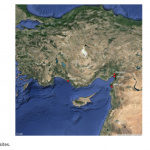

|
107 - 113 |